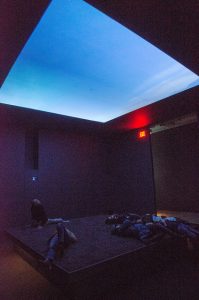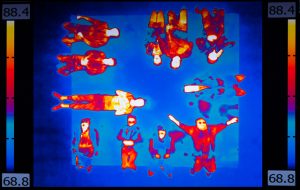The term Neo-liberalism gained traction in the late 80’s and early 90’s as governments around the world adopted drastic policies that dramatically altered the size and role of governments and corporations at the same time the Soviet Union was unwinding. Although the neoliberal theory proposes that human well-being will best be advanced when maximization of freedoms is achieved, Marxists such as David Harvey are keen in suggesting that in fact Neo-liberalism is quite simply a tool created to restore class dominance, and as such, should be handled with caution. Laura Poitras’ Astro Noise exhibition at the Whitney Museum confirms the latter view, and through a piercing exhibition she depicts the American war on terror.
Laura Poitras (born 1964) is an Oscar winning filmmaker who has made a career in denouncing U.S. occupation, torture, done programming and mass surveillance. Her first solo exhibition Astro Noise thoughtfully designed by Poitras herself, takes the viewer on five different spaces and times, all confronting the notions of liberty, freedom and private property. The name of the exhibition – Astro Noise- refers to the encrypted file named given by Edward Snowden to Poitras, which in turn is what partially inspired this exhibition.
The exhibition starts with O’ Say Can You See (2016), were a double channel video projection depicts- on one side- slow motions of people’s jarring faces just days after 9/11. The faces- although unearthed with shock and tremor- all seem to show an uncanny ease. On the adjacent side however, Poitras portrays two men crying and pleading in unsettling and inhuman conditions. These two men are Guantanmo detainees who are being held hostage and interrogated by American military personnel in regards to the planning of 9/11. The juxtaposition of both videos is compelling; it quickly confronts the viewer with the question of what liberty is and according to whom.
Related article:
In the next gallery, the viewer is invit ed to sit down, relax and watch the ceiling. Bed-down Location (2016) depicts beautiful sky views where flying drones can be seen flying over Yemen, Somalia and Pakistan. The very silent, but truer than ever-drone war becomes strikingly vivid for those who for different reasons –maybe physically not seeing and understanding this new war- are not well aware of the severity and magnitude it has in modernity.
ed to sit down, relax and watch the ceiling. Bed-down Location (2016) depicts beautiful sky views where flying drones can be seen flying over Yemen, Somalia and Pakistan. The very silent, but truer than ever-drone war becomes strikingly vivid for those who for different reasons –maybe physically not seeing and understanding this new war- are not well aware of the severity and magnitude it has in modernity.
In the next gallery, the spectator walks into Disposition Matrix (2016) which features small boxes laid around in different heights around the room. In order to read and see what is inside these boxes, the observer has to get up close and view the inscriptions inside these small boxes- asking him to literally use his body in search for information laid in the space. Viewers and introduced with videos and images of drones and legal documents from the C.I.A. and other organizations, all disclosing information about U.S occupation initiatives.
In the photo: Bed-Down Location. Photo Credit:© Edward Blake
The last part of the exhibition is a clip from 2004, by which Poitras comes to explain how “my life changed, although I didn’t know it at the time”, alluding to how she was put under U.S.A governmental watch list. Through an audiotape depicting Poitras voice, we are told how an American soldier was killed in Baghdad while she was documenting the American occupation. U.S.A intelligence determined she must have known about this incident prior of it happening, reason for which she has since been stopped every time she tries to cross a United States border. Worn-out with the situation, she filed a Freedom of Information Act lawsuit in 2015 where she received hundreds of documents confirming the extent by which she had been harassed. Many of these documents accompany the video and audiotape.
For a full mindmap behind this article with articles, videos, and documents see #astronoise
Freedom is wittily posed as an illusion inside a framework based on the exact opposite values that individual liberty and neoliberalism proposes.
 In the photo: Disposition Matrix. Photo Credit: © Edward Blake
In the photo: Disposition Matrix. Photo Credit: © Edward Blake
The exhibition ends not without having a witty twist. A monitor shows infrared images of the visitors in the adjacent gallery where Bed Room is in view. The surveyor realizes that he has both been recorded and watched as he is now watching others in the room where he had previously been. Through an infrared camera embedded in the gallery ceiling sending real time images to this monitor, the drone watchers are now being watched by others. Freedom is wittily posed as an illusion inside a framework based on the exact opposite values that individual liberty and neoliberalism proposes.
I cannot help to think of the immediate impact of this exhibition concerning the issues of liberty, privacy and how government surveillance has turned us all into possible targets. It makes one reflect on how these technological tools that were once created to allow more autonomy, are precisely the ones that make us more vulnerable to being spied and monitored. And in our eagerness to document and share our private lives in social media, we are only making ourselves subject to giving up our most sacred moments of our lives.
In the photo: Monitor showing infrared images from Bed Room. Photo Credit: © Edward Blake
Recommended reading: “FILMMAKER LAURA POITRAS TURNS HER ANTI-BIG BROTHER ACTIVISM INTO ART WITH ‘ASTRO NOISE’”












